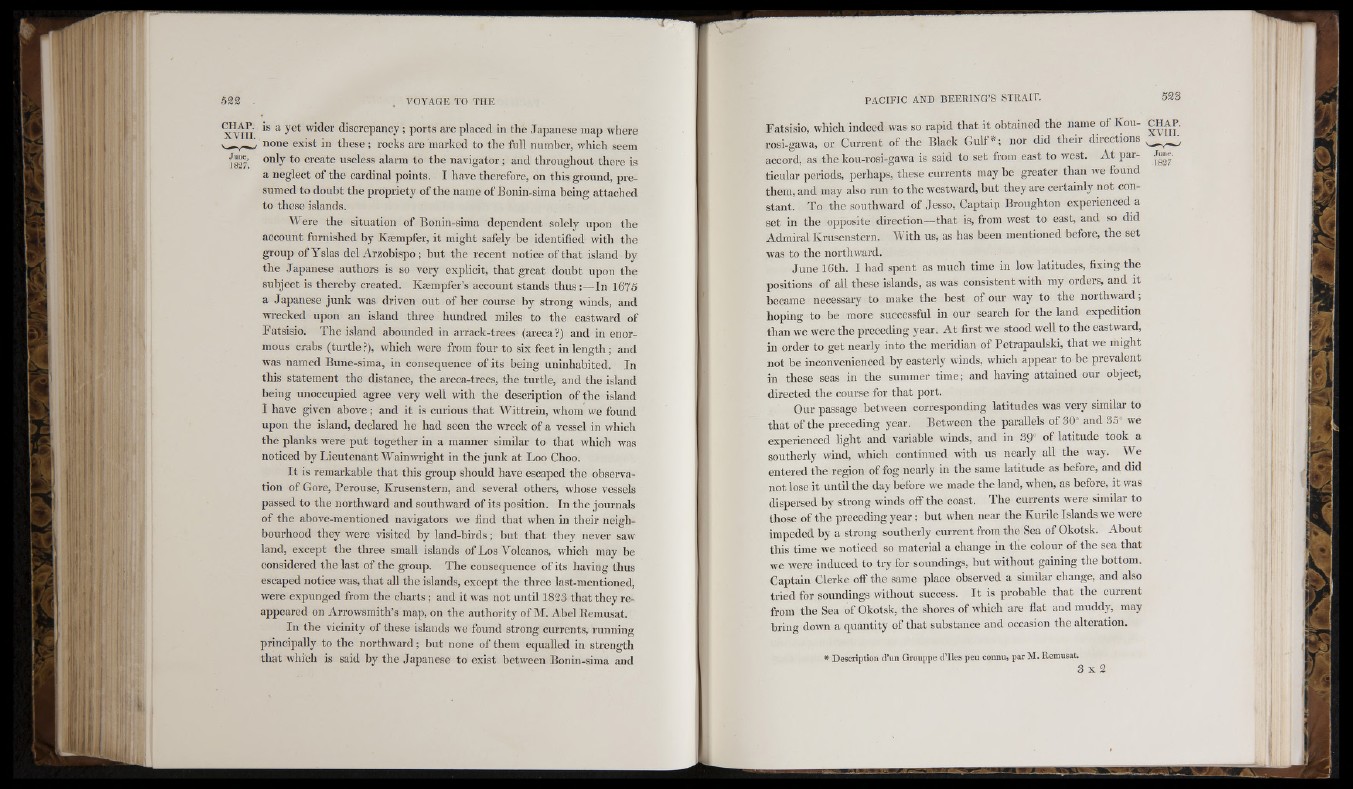
to';
toi;
M
i
I"
X t u í "'id®)' discrepancy ; ports are placed in the Japanese map where
none exist in the se; rocks are marked to the full number, wliich seem
fg"*’ ®))'y create useless alarm to the navigator; and throughout there is
a neglect of the cardinal points, I have therefore, on this ground, presumed
to doubt the propriety of the name of Bonin-sima being attached
to these islands.
AYere the situation of Bonin-sima dependent solely npon the
account furnished by Katmpfer, it might safely be identified with the
group of Yslas del Arzobispo; but the recent notice of that island by
the Japanese authors is so very explicit, that great doubt upon the
subject is thereby created. Kmmpfer’s account stands thus:—In 1675
a Japanese junk was driven out of her course by strong winds, and
WTecked upon an island three hundred miles to the eastward of
Fatsisio. The island abounded in arrack-trees (areca?) and in enormous
crabs (turtle.?), which were from four to six feet in length; and
was named Bune-sima, in consequence of its being uninhabited. In
this statement the distance, the areca-trees, the turtle, and the island
being unoccupied agree very well with the description of the island
I have given above; and it is curious that AATttrein, whom ive found
upon the island, declared he had seen the wreck of a vessel in ivhich
the planks ivere put together in a manner similar to that which was
noticed by Lieutenant AVainwright in the junk at Loo Choo.
It is remarkable that this group should have escaped the observation
of Gore, Perouse, Krusenstern, and several others, whose vessels
passed to the northward and southward of its position. In the journals
of the above-mentioned navigators we find that when in their neighbourhood
they were visited by land-birds ; but that they never saw
land, except the three small islands of Los A"oléanos, which may be
considered the last of the group. The consequence of its having thus
escaped notice was, that all the islands, except the three last-mentioned,
were expunged from the charts ; and it was not until 1823 that they reappeared
on Arrowsmith’s map, on the authority of M. Abel Eemusat.
In the vicinity of these islands w'e found strong currents, running
Fatsisio, which indeed was so rapid that it obtained the name of Kou- CHAP.
rosi-gawa, or Current of the Black Gulf*; nor did their directions --------
accord, as the kou-rosi-gawa is said to set from east to west. At particular
principally to the northward; but none of them equalled in strength
that which is said by the Japanese to exist between Bonin-sima and * Description d’un Grouppe dTles peu connu, par M. Remusat.
3 x 2
June.
1827
periods, perhaps, these currents may be greater than we found
them, and may also run to the westward, but they are certainly not constant.
To the southward of Jesso, Captaip Broughton experienced a
set in the opposite direction—that is, from west to east, and so did
Admiral Krusenstern. AVith us, as has been mentioned before, the set
was to the northward.
June I6th. I had spent as much time in low latitudes, fixing the
positions of all these islands, as was consistent with my orders, and it
became necessary to make the best of our way to the northward;
hoping to be more successful in our search for the land expedition
than we were the preceding year. At first we stood well to the eastivard,
in order to get nearly into the meridian of Petrapaulski, that we might
not be inconvenienced by easterly winds, ivhich appear to be prevalent
in these seas in the summer time; and having attained our object,
directed the course for that port.
Our passage between corresponding latitudes was very similar to
that ofthe preceding year. Between the parallels of 30° and 35° we
experienced light and variable winds, and in 39° of latitude took a
southerly wind, which continued with us nearly all the way. AVe
entered the region of fog nearly in the same latitude as before, and did
not lose it until the day before we made the land, ivhen, as before, it was
dispersed by strong winds otf the coast. The currents were similar to
those of the preceding year ; but ivhen near the Kurile Islands we were
impeded by a strong southerly current from the Sea of Okotsk. About
this time we noticed so material a change in the colour of the sea that
we were induced to try for soundings, but without gaining the bottom.
Captain Clerke otf the same place observed a similar change, and also
tried for soundings ivithout success. It is probable that the current
from the Sea of Okotsk, the shores of which are flat and muddy, may
bring down a quantity of that substance and occasion the alteration.